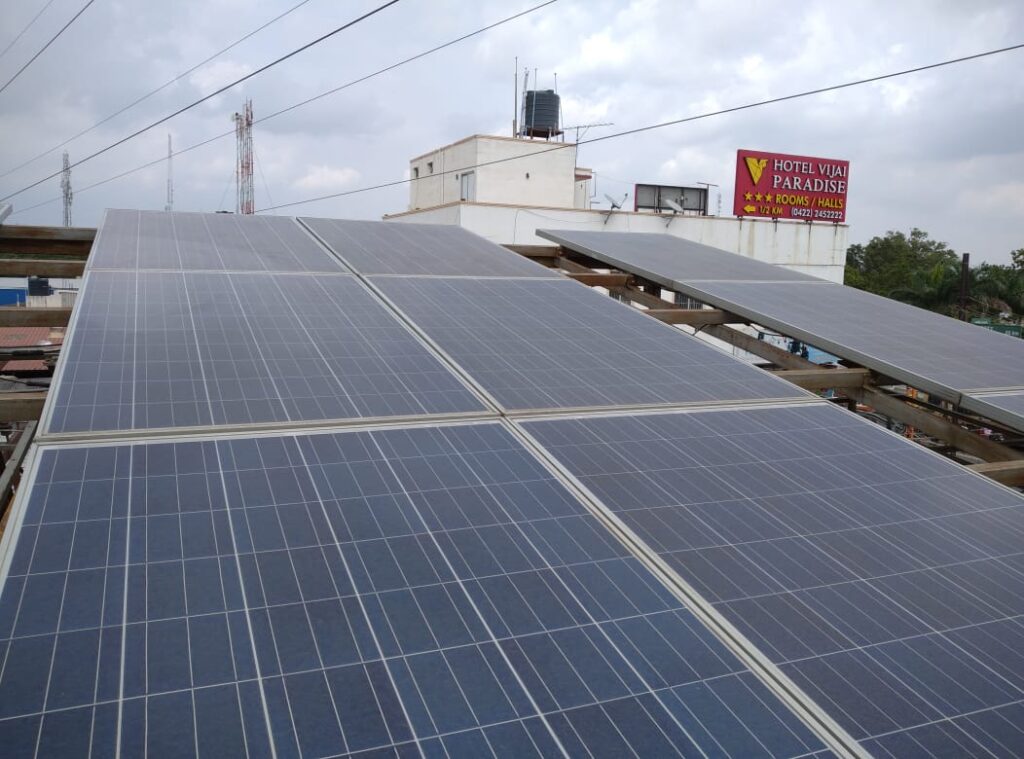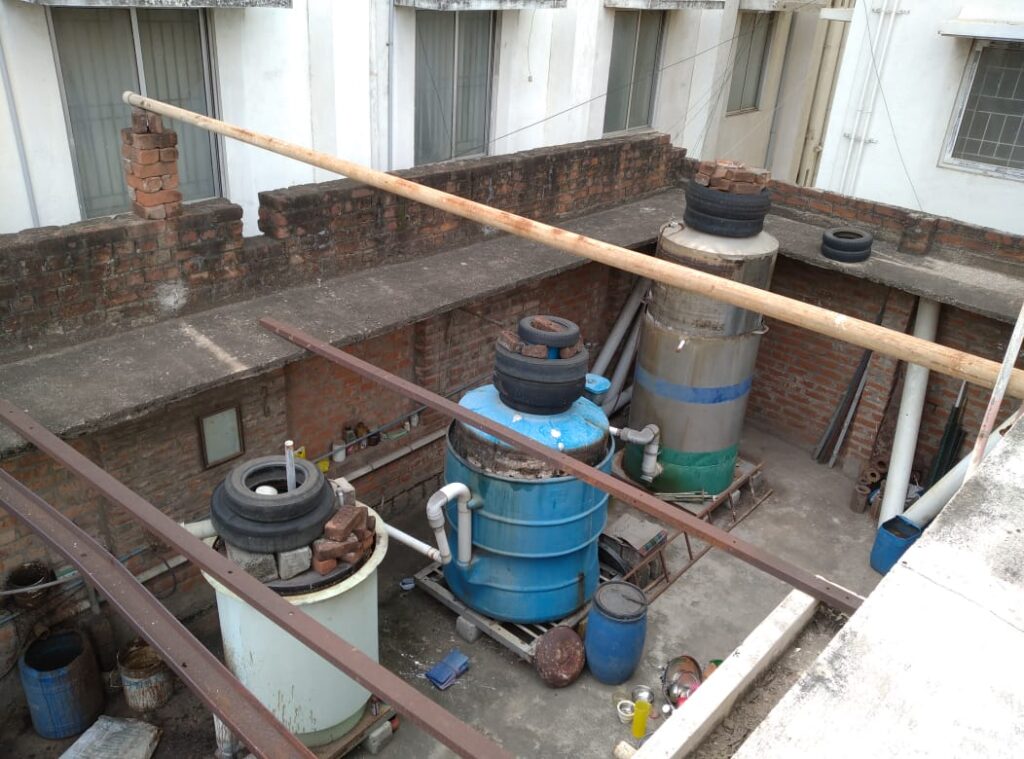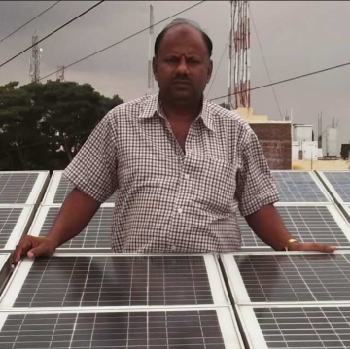The proverb, “make hay while the sun shines”, has a new version, “get solar power while the sunshine.” Sun being the superabundant source of power is the starting point of this journey. Sredhar took up the responsibility of saving the depleting resources of nature by utilising energy efficiently. He is not a professional in energy conservation. Still, he became the expert by a series of experiments conducted by him and with the help of guidance of a few great minds; he achieved a 100% self-energy sufficient home.
The primary source of his house electricity is solar, and that is why people call him ‘Solar Sredhar’. In a conversation with The EarthView, he revealed his journey of sustainable life.
Sredhar belongs to the land of Siruvani’ Coimbatore’. He began his work on energy utilisation with a mini hybrid plant, which is a windmill with a solar panel in his terrace.
“The professors of bio-energy department from Tamil Nadu Agriculture University (TNAU) guided me to build the hybrid plant,” said Sredhar who also holds the honour of initiating the 1st hybrid plant at home in the state of Tamil Nadu.
He lives in the area called Sai Baba Colony, which is one of the most densely populated areas in Coimbatore. With his initial trying efforts on the hybrid solar power plant for 2 years, he observed that windmill cannot be much more efficient in the dense zone of buildings. Varied wind patterns and factor affecting the harnessing wind power with hardly 100 days of wind with low wind velocity and very high wind velocity during July and August, he dropped hybrid plant and moved on to complete solar power. He said, “It is not advisable to use windmill in city zones.”
The experiment which started with a few panels is now a full-fledged project, resulting in house self-reliable for electricity which powered high energy-consuming appliances like a refrigerator, washing machine, air conditioner and supported all other electricity consuming appliances.

He further informed that a 3.5-kilowatt panel which yields production of 15 units of electricity is more than enough to support the electricity demands of a fully equipped house.
He also made his point clear that some might ask that ’15 units! Isn’t it surplus, do we really need this much amount of production for a single house?’ The reason behind the 12 panels is that in winter solar power production decreases to half (around 7 units of current) comparing to summer.
With sustainable measures, his house has been running without paying electricity bill for 9 whole years! An uninterrupted power supply and also shared the excess production to electricity board, which is utilized by the electric grid in his area. Sredhar has been awarded by ECO AWARDS 2012 for “innovative attempt towards making their home self-reliant for energy and power”. He also supported that it is possible for people who plan ongoing utterly solar power because the cost of solar panels has reduced much more than the time he installed it.
He also guided and helped many students to sharpen their ideas and knowledge on renewable resources. Sridhar also informed that a batch of students conducted their college projects with the help of his solar panels, and he also learned that according to latitude and longitude corrections his panel is facing the least production inclination and it must be in 12°NS for incident solar radiation.
The only thing which sorrows him is people reacting that solar is inefficient! The minor mistakes people make like a connection to earth gives them off-grid flow and waste of energy and make them think it is a waste of panels. He said that people should take proper guidance while installing solar panels or biogas plant. Quality is the most crucial parameter in conserving energy, he adds. Panels are a onetime investment which could save you big thousands in the upcoming years, so never compromise on the quality, he insisted.
Sridhar said, “Apart from solar panels, I have also made my kitchen renewable. So I dumped LPG for biogas power plant. As a beginner, my biogas extraction begun with organic kitchen wastes, which I found out to be developing fungal problems as the waste itself was biodegradable and wet waste. So I completely shifted my wet waste source into the dry source where I made my own R&D with biscuits. Later on, I also experimented with uncooked noodles, wafer sticks, etc. It might shocking but 2 biscuits from a 10 Rupees biscuit packets can cook my one day meal! Shop owners and people who live nearby supported me by not throwing the expired dry waste ingredients instead they place it in my waste storage. During the lockdown period, my storage was flooded with goods.”

In the initial years of biogas production, he used 2 biogas reactors of fibre build, which could hardly withstand 7 years. Later on, he studied the efficiency of materials for reactors and built his first biogas reactor one on his own, which is the 3rd biogas reactor supporting gas production. The material he chose for 3rd reactor is stainless steel, which being anticorrosive could withstand the outdoor atmosphere and rain that is the reason SS has a high life. He asked us to make sure that we should not add sand, stone, plastic and soaps, which are a great enemy to biogas reactor. For people facing common biogas production problems, he could solve it just with slurry observation. He assured that biogas produced is more for a meal, so he planned to utilise the excess biogas with biogas powered water heater.
He did not stop with solar and biogas. Still, on filling the thirsty aquifers, he made his attempt on rainwater harvesting too, which not only quenched the water demand of his house but also increased the groundwater level. He made the rainwater potable by adding filter bed materials such as charcoal, sand, coconut fibre, and curry leaves too, and candle type filter is an addon to make it more pure. This helped him to overcome the period when Siruvani river dam was facing water scarcity issue.
“These 3 green set up in my home could make me self sufficient for over 25 years! He said on a cheerful note. He also provides consulting services and also helps in the installation of panels for amateur energy conservationists. It is just a gist of my 10 years’ experience,” says Sredhar, who is the non-professional renewable energy expert from practice humbly.
Sredhar has shown the way to the future generation for self-reliable green energy production. So now it is our time to act nature responsibly and make good wealth out of waste.
Written by: Manju Pargavi

